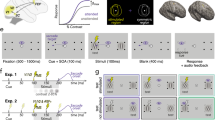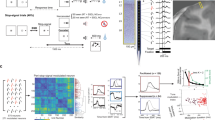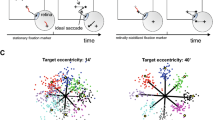Abstract
The supplementary eye field registers the occurrence of conflict, errors and reward in macaque monkeys performing a saccade-countermanding task. Using intracortical microstimulation, we determined whether the supplementary eye field only monitors or can actually influence performance. Weak microstimulation of many sites in the supplementary eye field improved monkeys' performance on a 'stop signal' task by delaying saccade initiation. This effect depended on the context of the task because simple visually guided saccades were not delayed by the same stimulation. These results demonstrate that the supplementary eye field can exert contextual executive control over saccade generation.
This is a preview of subscription content, access via your institution
Access options
Subscribe to this journal
Receive 12 print issues and online access
$209.00 per year
only $17.42 per issue
Buy this article
- Purchase on Springer Link
- Instant access to full article PDF
Prices may be subject to local taxes which are calculated during checkout





Similar content being viewed by others
References
Gehring, W.J., Gross, B., Coles, M.G.H., Meyer, D.E. & Donchin, E. A neural system for error detection and compensation. Psychol. Sci. 4, 385–390 (1993).
Falkenstein, M., Hohnsbein, J. & Hoormann, J. Event-related potential correlates of errors in reaction tasks. Electroencephalogr. Clin. Neurophysiol. Suppl. 44, 287–296 (1995).
Stuphorn, V., Taylor, T.L. & Schall, J.D. Performance monitoring by the supplementary eye field. Nature 408, 857–860 (2000).
Ito, S., Stuphorn, V., Brown, J.W. & Schall, J.D. Performance monitoring by the anterior cingulate cortex during saccade countermanding. Science 302, 120–122 (2003).
MacDonald, A.W., III, Cohen, J.D., Stenger, V.A. & Carter, C.S. Dissociating the role of the dorsolateral prefrontal and anterior cingulate cortex in cognitive control. Science 288, 1835–1838 (2000).
Gehring, W.J. & Knight, R.T. Prefrontal-cingulate interactions in action monitoring. Nat. Neurosci. 3, 516–520 (2000).
Ridderinkhof, K.R., Ullsperger, M., Crone, E.A. & Nieuwenhuis, S. The role of the medial frontal cortex in cognitive control. Science 306, 443–447 (2004).
Kerns, J.G. et al. Anterior cingulate conflict monitoring and adjustments in control. Science 303, 1023–1026 (2004).
Huerta, M.F. & Kaas, J.H. Supplementary eye field as defined by intracortical microstimulation: Connections in macaques. J. Comp. Neurol. 293, 299–330 (1990).
Luppino, G., Rozzi, S., Calzavara, R. & Matelli, M. Prefrontal and agranular cingulate projections to the dorsal premotor areas F2 and F7 in the macaque monkey. Eur. J. Neurosci. 17, 559–578 (2003).
Schall, J.D., Morel, A. & Kaas, J.H. Topography of supplementary eye field afferents to frontal eye field in macaque: implications for mapping between saccade coordinate systems. Vis. Neurosci. 10, 385–393 (1993).
Parthasarathy, H.B., Schall, J.D. & Graybiel, A.M. Distributed but convergent ordering of corticostriatal projections: analysis of the frontal eye field and the supplementary eye field in the macaque monkey. J. Neurosci. 12, 4468–4488 (1992).
Shook, B.L., Schlag-Rey, M. & Schlag, J. Primate supplementary eye field: I. Comparative aspects of mesencephalic and pontine connections. J. Comp. Neurol. 301, 618–642 (1990).
Schiller, P.H., True, S.D. & Conway, J.L. Deficits in eye movements following frontal eye-field and superior colliculus ablations. J. Neurophysiol. 44, 1175–1189 (1980).
Logan, G. & Cowan, W. On the ability to inhibit thought and action: a theory of an act of control. Psychol. Rev. 91, 295–327 (1984).
Dobson, A.J. An Introduction to Generalized Linear Models, 174 (Chapman and Hall, London, 1990).
Schall, J.D., Stuphorn, V. & Brown, J.W. Monitoring and control of action by the frontal lobes. Neuron 36, 309–322 (2002).
Fried, I. et al. Functional organization of human supplementary motor cortex studied by electrical stimulation. J. Neurosci. 11, 3656–3666 (1991).
Fujii, N., Mushiake, H., Tamai, M. & Tanji, J. Microstimulation of the supplementary eye field during saccade preparation. Neuroreport 6, 2565–2568 (1995).
Isoda, M. Context-dependent stimulation effects on saccade initiation in the presupplementary motor area of the monkey. J. Neurophysiol. 93, 3016–3022 (2005).
Martinez-Trujillo, J.C., Medendorp, W.P., Wang, H. & Crawford, J.D. Frames of reference for eye-head gaze commands in primate supplementary eye fields. Neuron 44, 1057–1066 (2004).
Izawa, Y., Suzuki, H. & Shinoda, Y. Suppression of visually and memory-guided saccades induced by electrical stimulation of the monkey frontal eye field. I. Suppression of ipsilateral saccades. J. Neurophysiol. 92, 2248–2260 (2004).
Schlag, J., Dassonville, P. & Schlag-Rey, M. Interaction of the two frontal eye fields before saccade onset. J. Neurophysiol. 79, 64–72 (1998).
Hanes, D.P. & Schall, J.D. Neural control of voluntary movement initiation. Science 274, 427–430 (1996).
Cavina-Pratesi, C., Bricolo, E., Prior, M. & Marzi, C.A. Redundancy gain in the stop-signal paradigm: implications for the locus of coactivation in simple reaction time. J. Exp. Psychol. Hum. Percept. Perform. 27, 932–941 (2001).
Botvinick, M., Braver, T.S., Barch, D.M., Carter, C.S. & Cohen, J.D. Conflict monitoring and cognitive control. Psychol. Rev. 108, 624–652 (2001).
Penfield, W. & Welch, K. The supplementary motor area of the cerebral cortex of man. Arch. Neurol. Psychiatry 66, 289–317 (1951).
Lim, S.H. et al. Functional anatomy of the human supplementary sensorimotor area: results of extraoperative electrical stimulation. Electroencephalogr. Clin. Neurophysiol. 91, 179–193 (1994).
Schlag, J. & Schlag-Rey, M. Evidence for a supplementary eye field. J. Neurophysiol. 57, 179–200 (1987).
Schall, J.D. Neuronal activity related to visually guided saccades in the frontal eye fields of rhesus monkeys: Comparison with supplementary eye fields. J. Neurophysiol. 66, 559–579 (1991).
Russo, G.S. & Bruce, C.J. Supplementary eye field: representation of saccades and relationship between neural response fields and elicited eye movements. J. Neurophysiol. 84, 2605–2621 (2000).
Schaeffer, E.A. Experiments on the electrical excitation of the cerebral cortex in monkey. Brain 11, 1–6 (1888).
Walker, E.A. & Weaver, T.A. Ocular movements from the occipital lobe in monkey. J. Neurophysiol. 3, 369–378 (1940).
Wagman, I.H., Krieger, H.P. & Bender, M.B. Eye movements elicited by surface and depth stimulation of the occipital lobe of Macaque mulatta. J. Comp. Neurol. 109, 169–193 (1958).
Schiller, P.H. The effect of superior colliculus ablation on saccades elicted by cortical stimulation. Brain Res. 122, 154–156 (1977).
Keating, E.G., Gooley, S.G., Pratt, S.E. & Kelsey, J.E. Removing the superior colliculus silences eye movements normally evoked from stimulation of the parietal and occipital eye fields. Brain Res. 269, 145–148 (1983).
Tehovnik, E.J., Slocum, W.M. & Schiller, P.H. Saccadic eye movements evoked by microstimulation of striate cortex. Eur. J. Neurosci. 17, 870–878 (2003).
Stoney, S.D., Jr, Thompson, W.D. & Asanuma, H. Excitation of pyramidal tract cells by intracortical microstimulation: effective extent of stimulating current. J. Neurophysiol. 31, 659–669 (1968).
Hanes, D.P., Patterson, W.F., II & Schall, J.D. Role of frontal eye fields in countermanding saccades: visual, movement, and fixation activity. J. Neurophysiol. 79, 817–834 (1998).
Hanes, D.P. & Schall, J.D. Countermanding saccades in macaque. Vis. Neurosci. 12, 929–937 (1995).
Efron, B. & Tibshirani, R.J. An Introduction to the Bootstrap, 436 (Chapman & Hall/CRC, Boca Raton, 1993).
Acknowledgements
We thank K. Reis for help with the figures and L. Boucher, J. Brown, S. Hsiao, E. Niebur, P. Pouget and K. Thompson for helpful comments. V.S. was supported by a Deutsche Forschungsgemeinschaft research fellowship (STU 272/1-1). This work was also supported by R. Patton through the E. Bronson Ingram Chair of Neuroscience at Vanderbilt University and by the US National Institutes of Health (grants RO1-MH55806, P30-EY08126 and P30-HD015052).
Author information
Authors and Affiliations
Corresponding author
Ethics declarations
Competing interests
The authors declare no competing financial interests.
Rights and permissions
About this article
Cite this article
Stuphorn, V., Schall, J. Executive control of countermanding saccades by the supplementary eye field. Nat Neurosci 9, 925–931 (2006). https://doi.org/10.1038/nn1714
Received:
Accepted:
Published:
Issue Date:
DOI: https://doi.org/10.1038/nn1714
This article is cited by
-
Neurophysiological mechanisms of error monitoring in human and non-human primates
Nature Reviews Neuroscience (2023)
-
Functional architecture of executive control and associated event-related potentials in macaques
Nature Communications (2022)
-
The unknown but knowable relationship between Presaccadic Accumulation of activity and Saccade initiation
Journal of Computational Neuroscience (2021)
-
Efficacy of inhibitory control depends on procrastination and deceleration in saccade planning
Experimental Brain Research (2020)
-
New Cerebello-Cortical Pathway Involved in Higher-Order Oculomotor Control
The Cerebellum (2020)



